The severity of the bite is the main difference between the Black Widow and the Brown Widow. The Black Widow’s bite is more painful with higher chances of secondary effects such as pain. There’s almost twice more venom injected by the Black Widow with each bite compared to the generally less aggressive Brown Widow.
Table of Contents
What Are Brown Widows?
Brown Widows are part of the Latrodectus genus. These spiders have brown, black, and tan colorations with black markings. Brown Widow females are further characterized by an abdominal stripe and 3 stripes on the flanks.
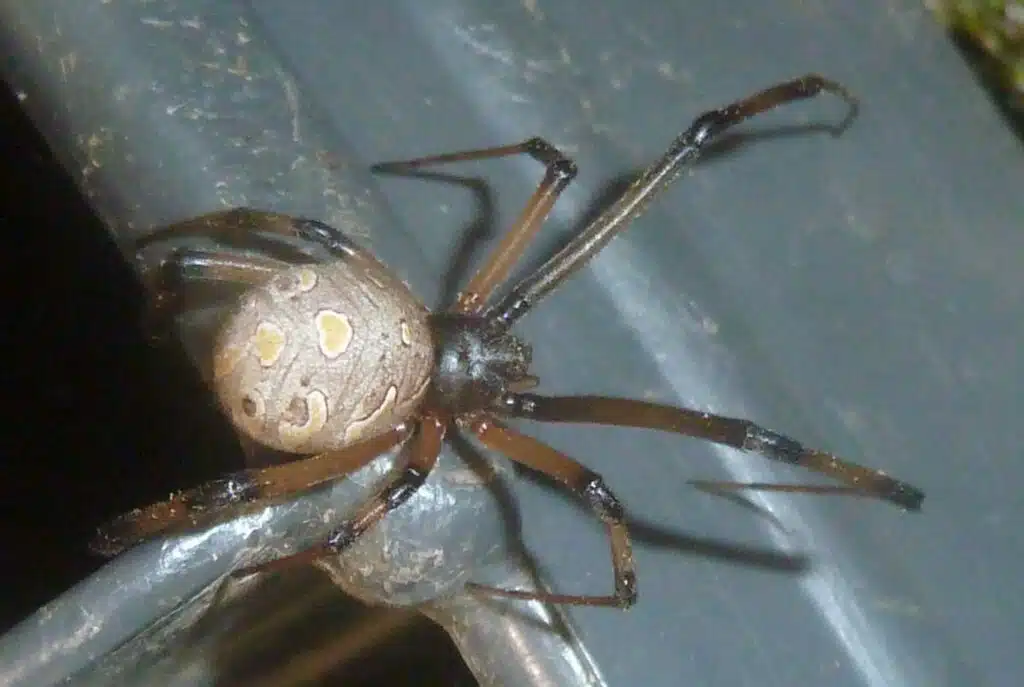
The Brown Widow also has a distinct hourglass marking on its body. This is an orange hourglass marking and not a red hourglass marking such as on the Black Widow.
Brown Widows grow to a size of 5 inches (including legs). Females reach this size while males grow up to 3 inches.
Brown Widows reproduce a few times per life. These spiders are known for a high number of eggs. Each female Brown Widow lays around 120 eggs per sac after each mating season. It’s estimated up to 20 egg sacks of at least 120 eggs are laid by the female Brown Widow.
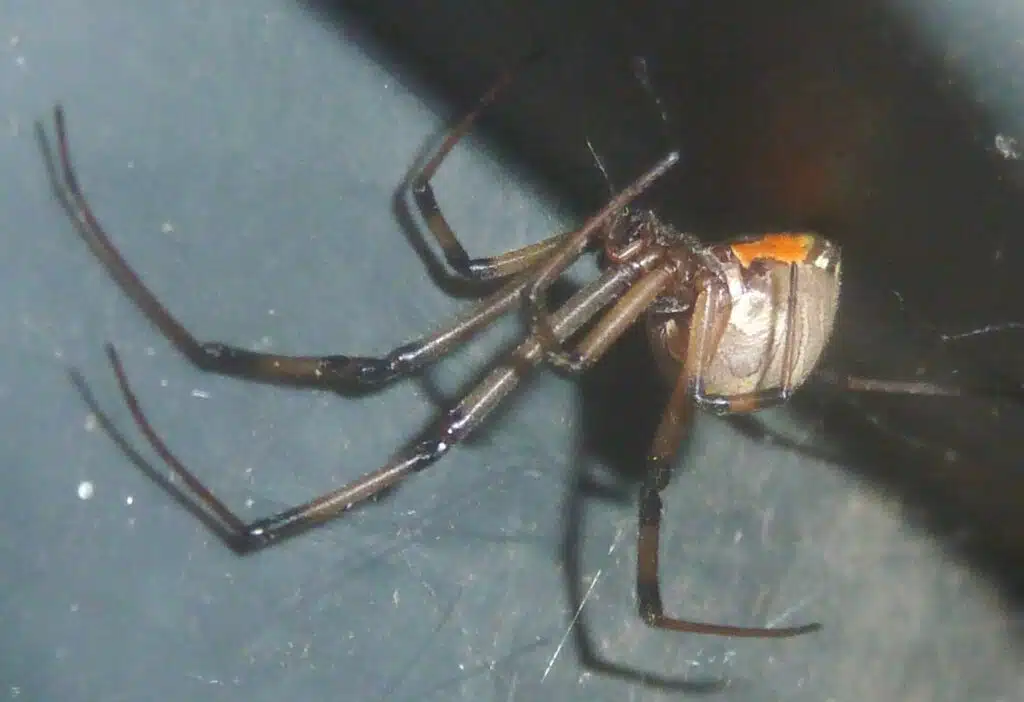
Brown Widow bites aren’t considered very dangerous for humans. They are associated with pain and skin redness. But these are symptoms of most types of household spider bites. The scientific literature mentions rare cases where hospitalization was needed following a Brown Widow bite.
The Brown Widow prefers secluded places to build its web. It lives in woodlands and dense vegetation. It prefers empty containers and areas to build its web when present around households. This includes the mailbox and empty buckets. It’s also present in corners.
Since the Brown Widow prefers to live closer to humans than the Black Widow, there’s a false risk of higher dangerousness associated with this spider.
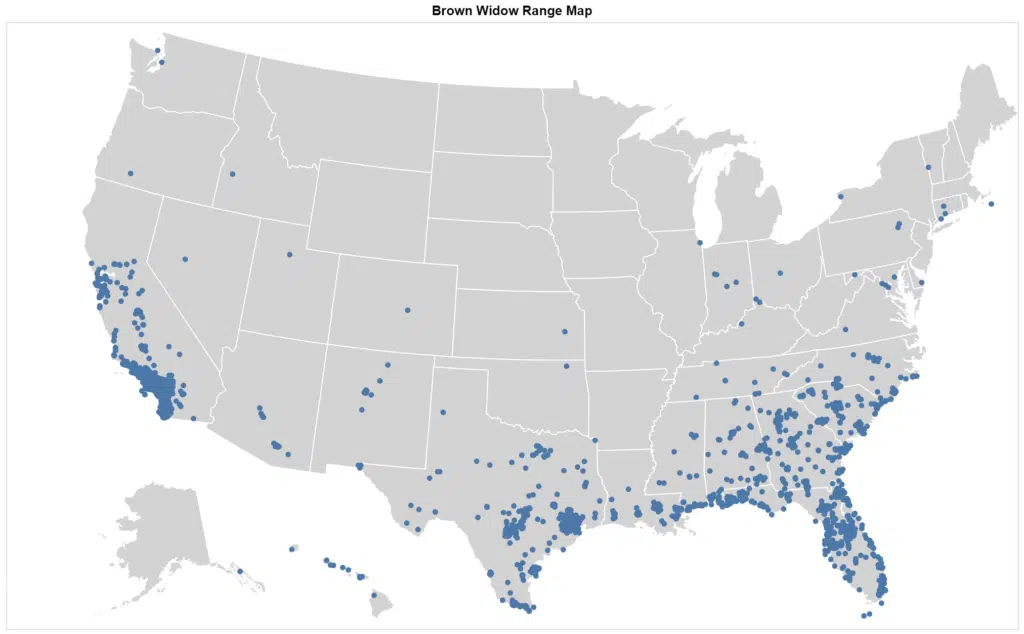
The Brown Widow is not a North American species. It’s an introduced spider species. The Brown Widow is believed to have first arrived in the US through Florida. Its Central and Southern Florida presence has grown considerably ever since.
Today, the Brown Widow is present in almost all Southern states with rapid growth. Otherwise, the spider is a constant tropical presence.
What Are Black Widows?
Black Widows have feared spiders with venomous bites. These spiders have a black body with a red hourglass marking that makes them instantly recognizable.
A bite from this spider comes with pain and redness. In some cases, it requires hospitalization. Black widow children and elderly bites can sometimes lead to death.
This notorious spider has distinct characteristics such as a cannibalistic nature. The female eats the male spider after mating. There are 3 types of Black Widow spiders in the US.
Northern Black Widow
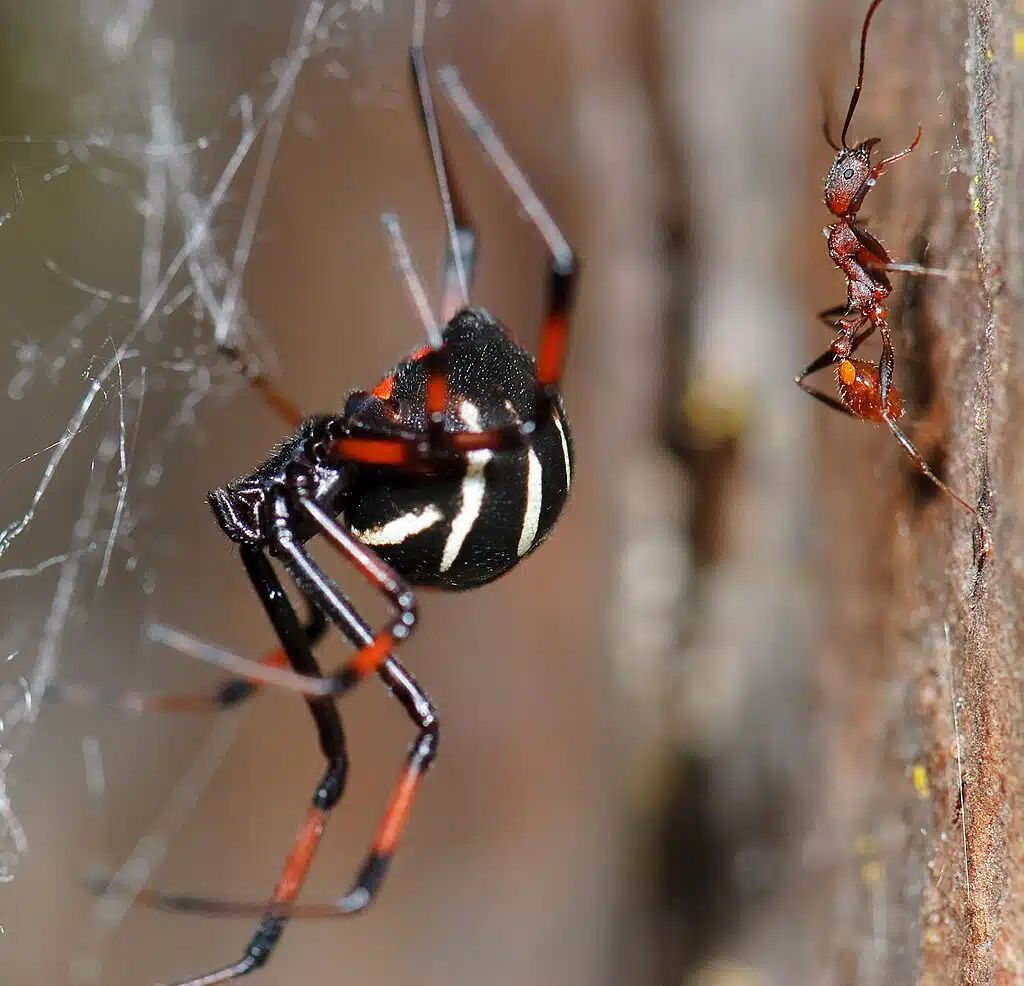
The Northern Black Widow lives in the Eastern part of the United States and Canada. It shares common territories with the Southern Black Widow but it has a larger presence in the North-Eastern part of the country.
This spider doesn’t only differ in territorial presence but it differs in looks as well. The Northern Black Widow has a black body. But the red hourglass marking is split in two. There are 2 smaller hourglass markings instead of the standard red hourglass marking on the Southern Black Widow.
This spider can be further identified by this hourglass marking. The lower part of the mark that sits on the lower part of the body is a bit more rounded than the top triangular part of the hourglass marking. This spider reaches a maximum size of 5 inches.
This is how the spider looks when it reaches adulthood. But the Northern Black Widow also has white and red markings in its early days.
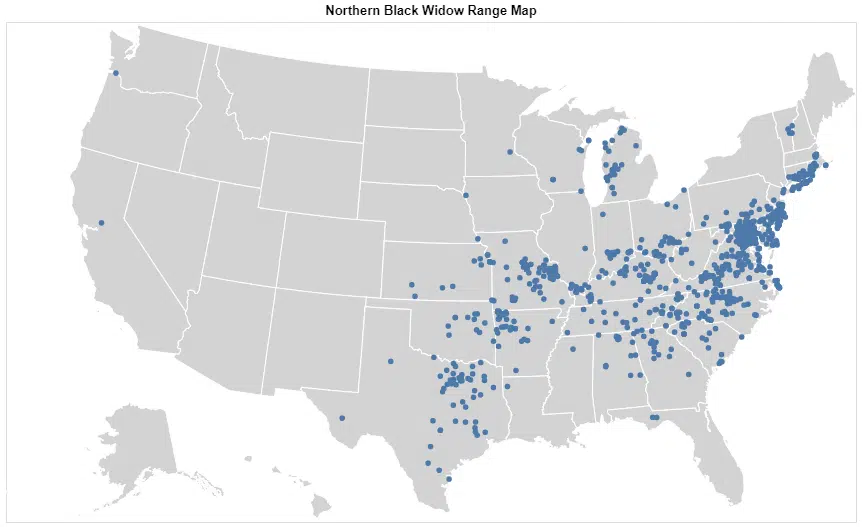
Southern Black Widow
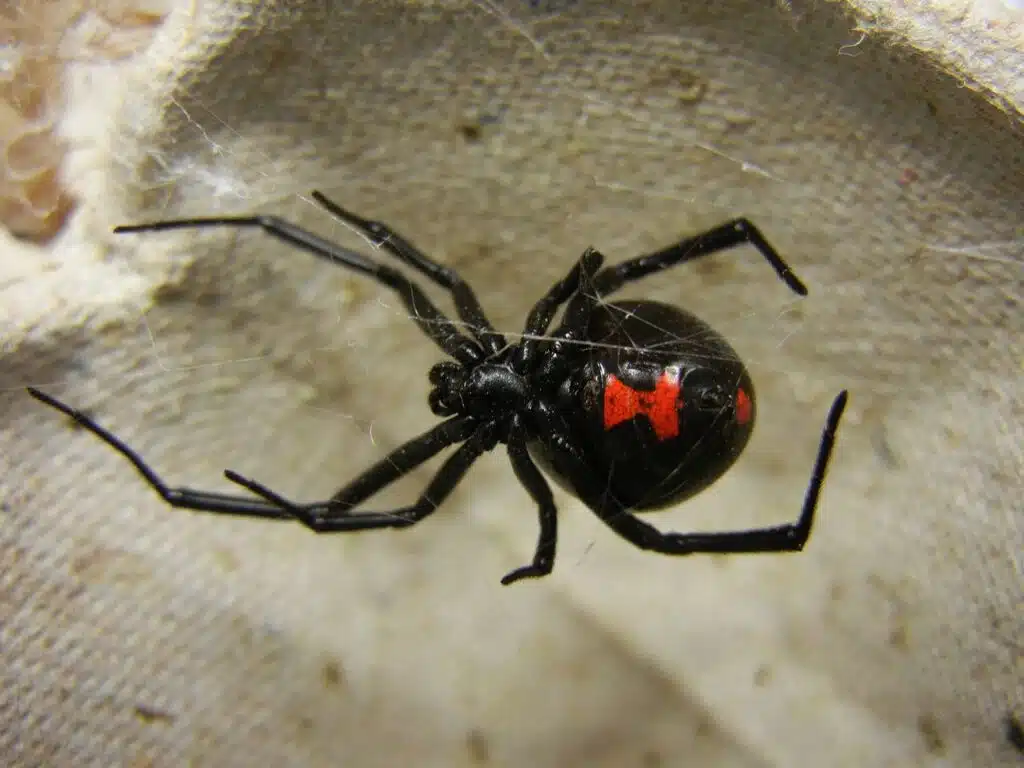
The Southern Black Widow is present in most Southern states. It’s a type of black spider with a potentially dangerous bite. This spider grows to a size of 5 inches. The female reaches this size while the male grows a few inches smaller.
This spider has a black body with a complete red hourglass marking on its body. The bottom part of the hourglass figure has rounded shapes instead of triangular shapes.
The female Southern Black Widow is considered dangerous while the male is considered not dangerous at all. The female’s bite can cause severe pain and may require hospitalization.
These spiders are nocturnal which means they only come out at night. They spin a web but it’s not a spider web many people expect as it looks more like a cobweb than a classic round garden spider web.
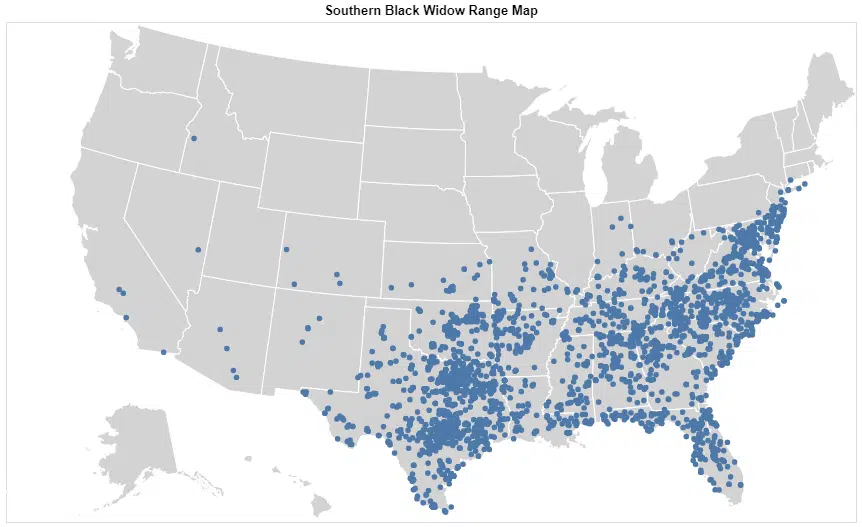
Western Black Widow
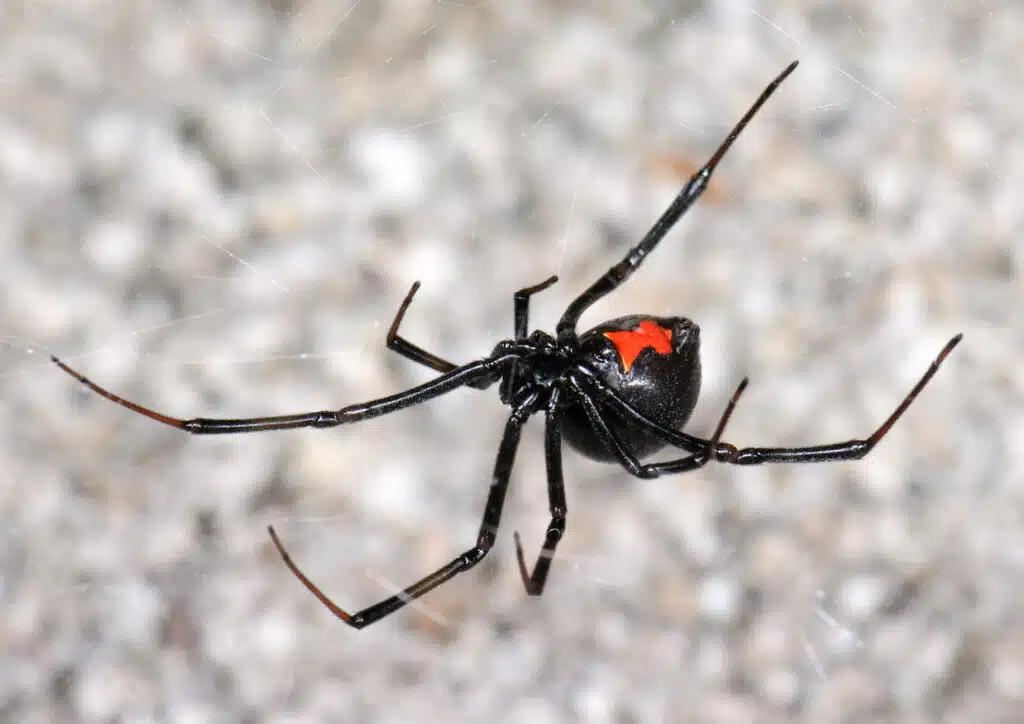
The Western Black Widow is present in the Western and Southern parts of the United States. It resembles all other types of Black Widows but it has a different hourglass marking particularity.
This spider has a black body with a complete red hourglass marking. The bottom part of the hourglass that’s furthest from the head is slimmer than the top part of the marking.
This spider reaches a maximum length of 5 inches. Females weave webs that resembled cobwebs rather than traditional circular spider webs.
This spider is normally not aggressive. However, it bites when under pressure or when it feels threatened. Its bite comes with pain and redness and it can require hospitalization.
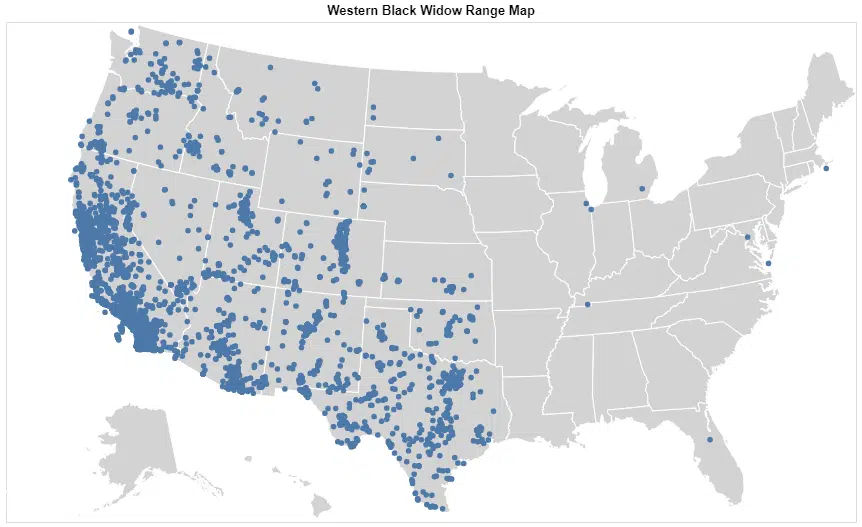
Similarities Between Brown Widows and Black Widows
Both Brown widows and Black widows have similarities, even if these have different types of reactions when they bite.
Size
Both spiders have larger females and smaller males. Black and Brown Widow spiders have females that reach a size of up to 5 inches. Males are normally 1/3 smaller than females.
The size is what determines the strength of overpowering females over males. These spiders can kill the male counterpart after mating.
Hourglass marking
Both spiders have hourglass markings. While these differ in color, they indicate a spider of the Latrodectus family. It can also be a clear identification method and an indication the spider needs to be destroyed if found inside the house.
Prey
Mosquitoes, flies, beetles, grasshoppers, and caterpillars are among the favorite prey of these spiders. They generally attack smaller insects but they can often attack larger insects that get caught up in the spider web given they have powerful venom.
Differences Between Brown Widows And Black Widows
One of the most notable differences between the Brown Widow and the Black Widow is the seriousness of the reactions once bitten. However, there are other facts to consider as well.
Color
The Black Widow spider is black while the Brown Widow spider has brown coloration.
These spiders have hourglass figures of different aesthetics as well. There’s a deep red hourglass figure marking on the Black Widow while the hourglass marking on the Brown Widow is slightly faded with an orange border once observed from a close distance.
Aggressiveness
The aggressive nature of these spiders is also different. The Black Widow tends to bite when provoked or when its eggs are in danger.
The Brown Widow tends to run away as often as possible only resorting to a bite when cornered.
Venom
The venom injected with a bite is different in these spiders. It’s believed the venom of the Black Widow is more troublesome than the venom of the Brown Widow. Hospitalization is not needed following most Brown Widow bites.
Habitat
The habitats of these spiders are similar but slightly different. The Black Widow is a bit more aggressive by nature and a bit more adventurous. The Brown Widow prefers to live closer to humans even if still protected by elements such as the immediate surrounding of its spider web.
This preference of the Brown Widow to live close to humans often leads to the misconception of higher numbers when in reality it only lives closer to households.
What To Do When You See Venomous Spiders In Your House
You need to remove a Black Widow or a Brown Widow from your house immediately when you see one. The best solution is to kill it and not release it near your house.
Use vinegar
It’s believed vinegar burns and kills spiders. You can mix 50% water and 50% vinegar in an empty spray bottle and spray the spider to kill it.
Vacuum the spider
A vacuum cleaner can be used to remove the spider. You will need to destroy the vacuum cleaner’s dust bag or empty the dust compartment ensuring you kill the spider properly as vacuuming doesn’t kill these two types of spiders.
How To Prevent Venomous Spiders
The best defense against these spiders is to prevent them from entering your house in the first place. When you see one of these spiders near your house or in the garage it’s a sign you need to take action to keep them away in the future.
Seal cracks
The first thing to do is seal all the cracks where these spiders can crawl through right into your house. Spaces near windows and under doors are ideal crawling spaces for these spiders. You need to seal off all tiny spaces to keep them out for good.
Control moisture levels
Moisture attracts Black and Brown Widow spiders. High moisture level around the house is not recommended. You need to control the moisture level of your lawn and other water sources around the house to keep these spiders away.
Low moisture will also deter mosquitoes that Black and Brown Widow spiders love to eat.
Spray lemon essential oil
Lemon, peppermint, and eucalyptus oils are believed to be disliked by these spiders. You can add these essential oils to a mixture of water and spray it around the windows, doors, and on the outer walls of your house. You can also spray your garage with these scented oils.
The outer spaces of your house can also be sprayed with chemicals and pesticides which are stronger and more efficient as a result.
Limit outdoor lights
Black Widows are nocturnal spiders. You might not even see them at all since they only come out at night. Limiting light sources inside and outside of the house during the night is essential to keep these spiders out.
One of the methods of limiting outside light sources is to place them further away from the house. This still provides backyard illumination during the night but the lights aren’t installed directly on the house which can attract these and other spiders together with mosquitoes and other flies.
Remove ideal web-building spots
Some spiders prefer small crawl-into spaces that are rarely visited by humans. Stacks of firewood are ideal spaces for these spiders to build their webs. It’s ideal to remove stacks of wood near the house to limit possible habitats.
You can either move the firewood further into the backyard or consider having a sealed shed for your firewood that doesn’t attract spiders.
Summary
Both the Black Widow and the Brown Widow are some of the most dangerous spiders that live in the United States. While also present in Canada and Mexico, these spiders have a growing population across the US.
Their venom is dangerous and their bite is painful. This is why it’s best to avoid direct contact and to eliminate these spiders when you see them.
The Black Widow spider is more aggressive and it will bite given the opportunity. However, its nocturnal nature makes it hard to spot around the house. It’s best to take preventive measures to stop it from building its unusual cobweb-style spider web near your house.
The Brown Widow spider loves to live in the garage, in empty buckets, or the mailbox. It’s best to keep these clean and clear at all times to keep this spider away. While not as dangerous, Brown Widow bites still happen.
It’s best to plant pungent plants such as mint and lavender near the house to keep these spiders away in the first place.
Further Reading: